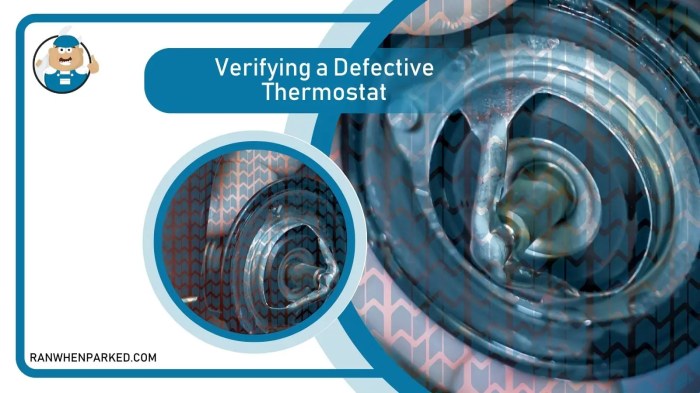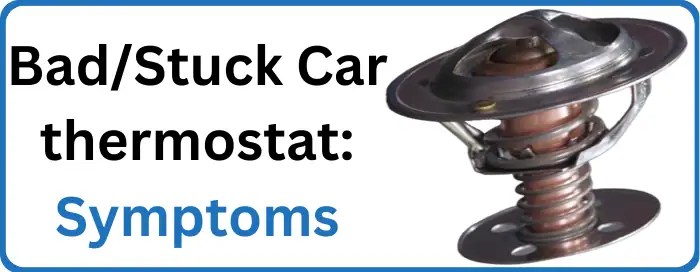A malfunctioning car thermostat can significantly impact your vehicle’s performance and longevity. Understanding the subtle signs of thermostat failure is crucial for preventing costly engine damage. This guide delves into nine common symptoms, providing you with the knowledge to identify potential issues early and ensure your car runs smoothly.
From unusual temperature fluctuations to reduced engine efficiency, recognizing these warning signs can save you from unexpected breakdowns and expensive repairs. We’ll explore the underlying causes, diagnostic procedures, and potential consequences of a faulty thermostat, empowering you to maintain your vehicle’s health proactively.
Identifying the Nine Symptoms

A malfunctioning car thermostat can significantly impact your vehicle’s performance and engine health. Recognizing the symptoms early is crucial for preventing more serious and costly repairs. This section details nine common indicators of a failing thermostat, their severity, and the underlying causes.
Understanding the relationship between these symptoms and a faulty thermostat allows for timely diagnosis and repair, protecting your engine from potential damage. The following table summarizes these symptoms, their impact, and potential consequences.
Symptom Descriptions and Impact on Engine Health
| Symptom | Description | Impact on Engine | Potential Consequences |
|---|---|---|---|
| Overheating | The engine temperature gauge consistently reads high, potentially exceeding the safe operating range. The engine may even overheat, leading to visible steam or smoke. | Excessive heat can warp engine components, damage the head gasket, and cause catastrophic engine failure. | Engine seizure, head gasket failure, warped cylinder heads, costly repairs or engine replacement. |
| Sluggish Engine Performance | The engine feels sluggish, lacking power, and struggles to accelerate. | Reduced engine efficiency due to improper operating temperature. The engine may be running too cold, hindering optimal combustion. | Decreased fuel economy, increased emissions, potential long-term engine damage. |
| Poor Fuel Economy | Noticeably lower miles per gallon than usual. | Inefficient combustion due to incorrect engine temperature. The engine may be running too cold or too hot. | Increased fuel costs, unnecessary expenditure on fuel. |
| Erratic Temperature Gauge Readings | The engine temperature gauge fluctuates wildly, swinging between hot and cold. | Indicates inconsistent engine temperature regulation, leading to inefficient combustion and potential overheating. | Engine damage from fluctuating temperatures, premature wear and tear. |
| Heater Issues | The heater blows cold or lukewarm air, even when the engine is at operating temperature. | The thermostat is preventing coolant from circulating through the heater core. | Passenger discomfort, particularly in cold weather. |
| Engine Misfires | The engine may misfire or run roughly, particularly when cold. | Improper engine temperature can disrupt the ignition timing and fuel delivery. | Reduced engine power, potential damage to catalytic converter. |
| Coolant Leaks | Leaks may be observed around the thermostat housing or other related components. | A faulty thermostat may cause pressure buildup within the cooling system, leading to leaks. | Loss of coolant, potential overheating, and engine damage. |
| White Exhaust Smoke | White smoke from the exhaust, especially noticeable during cold starts, can indicate coolant leakage into the combustion chamber. | This is a severe symptom suggesting a significant problem, often linked to a head gasket failure exacerbated by overheating caused by the faulty thermostat. | Major engine repair, potential engine failure. |
| Check Engine Light | The check engine light illuminates, often accompanied by a diagnostic trouble code (DTC) related to coolant temperature or engine temperature sensors. | The car’s computer detects an issue with the cooling system’s temperature regulation. | Requires diagnostic scan to identify the specific problem, potentially pointing to the thermostat. |
Diagnosing a Failing Thermostat

Accurately diagnosing a failing thermostat requires a methodical approach, combining visual inspection with checks of coolant temperature and engine behavior. Misdiagnosis can lead to unnecessary repairs or, worse, further engine damage. Therefore, a careful and systematic procedure is crucial.
Diagnosing a faulty thermostat involves several key steps to isolate the problem and confirm its source. These steps help differentiate thermostat failure from issues in other engine components that might exhibit similar symptoms.
Coolant Temperature Verification Methods
Several methods exist for determining if the coolant is reaching the correct operating temperature. Inaccurate temperature readings can point to a malfunctioning thermostat or other problems within the cooling system.
- Using a Temperature Gun (Infrared Thermometer): This non-invasive method allows for a quick temperature reading of the coolant hose near the thermostat housing. A significant temperature difference between the inlet and outlet hoses, particularly when the engine is warmed up, strongly suggests a malfunctioning thermostat. A reading significantly below the expected operating temperature (usually around 195-220°F or 90-105°C) indicates the thermostat might be stuck closed, restricting coolant flow.
- Checking the Coolant Temperature Gauge: The vehicle’s instrument panel usually includes a coolant temperature gauge. While not always precise, a gauge consistently reading low or slow to reach operating temperature suggests a possible thermostat problem. However, gauge malfunction should also be considered.
- Using an OBD-II Scanner: Many modern vehicles use an OBD-II system which provides real-time data, including coolant temperature. An OBD-II scanner can give a more accurate reading than the dashboard gauge. A consistently low coolant temperature reading compared to the engine’s operating temperature confirms thermostat malfunction.
Diagnostic Flowchart
The following flowchart Artikels the diagnostic process for a suspected faulty thermostat:
[Imagine a flowchart here. The flowchart would begin with “Engine Overheating/Poor Engine Warm-up?” A “Yes” branch would lead to “Check Coolant Temperature (Gauge, IR Thermometer, OBD-II Scanner).” A “No” branch would lead to “Check other potential causes (water pump, radiator, sensor issues).” From “Check Coolant Temperature,” a “Low Temperature Reading” branch would lead to “Suspect Faulty Thermostat (stuck closed).” A “Normal Temperature Reading” branch would lead to “Check other potential causes (water pump, radiator, sensor issues).” Finally, a “High Temperature Reading” branch would lead to “Suspect Faulty Thermostat (stuck open) or other cooling system issues.”]
Potential Mimicking Symptoms
Several other components can exhibit symptoms similar to a failing thermostat, making accurate diagnosis crucial.
- Faulty Water Pump: A malfunctioning water pump, unable to circulate coolant effectively, can cause similar symptoms to a thermostat stuck closed, resulting in poor engine warm-up or overheating. The water pump’s impeller might be worn or the pump itself might be failing.
- Clogged Radiator: A radiator clogged with debris can restrict coolant flow, mimicking the effects of a thermostat stuck closed. This will cause the engine to overheat.
- Faulty Coolant Temperature Sensor: An inaccurate coolant temperature sensor provides false readings to the engine control unit (ECU), potentially masking the actual thermostat condition. The ECU might adjust engine behavior based on this incorrect data, leading to misinterpretations.
Understanding Thermostat Function and Failure Modes

The car thermostat is a crucial component of the engine cooling system, acting as a temperature regulator to maintain optimal operating temperatures. Its proper functioning is essential for preventing engine overheating and ensuring efficient performance. Understanding how it works and the ways it can fail is key to diagnosing cooling system problems.
The thermostat is a valve located in the engine’s cooling system, typically within the engine block or a housing connected to it. It controls the flow of coolant between the engine and the radiator. When the engine is cold, the thermostat remains closed, restricting coolant flow to the radiator and allowing the engine to warm up quickly. Once the engine reaches its optimal operating temperature (usually around 195-220°F or 90-105°C), the thermostat opens, allowing coolant to circulate through the radiator where it’s cooled before returning to the engine. This continuous cycle maintains a stable engine temperature.
Thermostat Operation and Cooling System Diagram
The following diagram illustrates the typical components of a vehicle’s cooling system and the role of the thermostat:
Imagine a diagram showing a simplified car engine. Coolant flows from the engine block, passing through the thermostat housing. The thermostat is depicted as a valve inside the housing. When closed, the coolant flows directly back into the engine block, bypassing the radiator. When open, the coolant flows from the thermostat housing into the upper radiator hose, then through the radiator where it is cooled, and finally back to the engine block via the lower radiator hose and water pump. The water pump circulates the coolant constantly. A pressure cap on the radiator maintains system pressure. A temperature sensor monitors coolant temperature and sends signals to the engine control unit (ECU).
Thermostat Failure Modes
A car thermostat can fail in several ways, primarily by becoming stuck open or stuck closed. These failures significantly impact engine performance and can lead to serious damage if not addressed promptly.
Effects of Thermostat Failure
A thermostat stuck open allows coolant to continuously circulate through the radiator, preventing the engine from reaching its optimal operating temperature. This can lead to sluggish performance, increased fuel consumption, and potentially damage to the engine due to incomplete combustion and excessive wear. Conversely, a thermostat stuck closed prevents coolant from circulating, causing the engine to overheat. This can lead to warped cylinder heads, cracked engine blocks, and blown head gaskets – all very expensive repairs.
Comparison of Failure Modes and Their Effects
| Failure Mode | Symptoms | Potential Damage |
|---|---|---|
| Stuck Open | Engine runs cold, poor performance, increased fuel consumption, longer warm-up times | Increased engine wear, decreased fuel efficiency |
| Stuck Closed | Engine overheats, overheating warning light illuminates, steam from the engine compartment, potential loss of coolant | Warped cylinder head, cracked engine block, blown head gasket, catastrophic engine failure |
Last Word

Ignoring the symptoms of a failing car thermostat can lead to serious engine problems, emphasizing the importance of prompt diagnosis and repair. By understanding the nine common indicators discussed here, and knowing when to seek professional help, you can protect your vehicle’s engine and avoid potentially costly repairs. Regular maintenance checks and paying attention to your car’s behavior are key to preventing unexpected issues and keeping your vehicle running optimally.